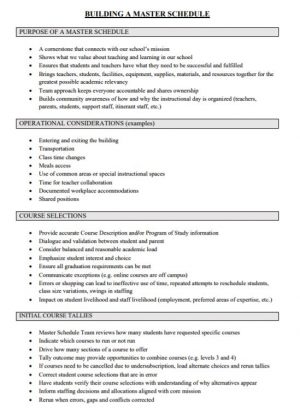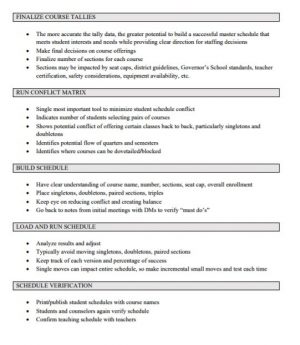Demystifying Course Registration
February 2, 2018
230, according to the TJHSST Course Guide. The number of courses available for students at Jefferson.
28. The number of year-long courses students have space for in their schedules over their four years. Add in a few semester courses, and that number can jump to between 31 or 33.
With such a discrepancy between the number of classes offered and the number that students take, scheduling courses can be a challenging process for students and the administration. With the curriculum fair today, students are more anxious to determine what courses would suit them best in the coming school year and what they should sign up for before the administration starts determining schedules for the coming school year.
Dr. Ann Bonitatibus sat down with tjTODAY to answer questions from the student body regarding course scheduling.
What is the timeline for course scheduling and creation of the master schedule?
“The purpose of a master schedule is to reflect the mission and the purpose of your school,” Bonitatibus said. “It’s the foundation of the entire instructional program.”
Courses for the coming school year are decided starting mid-November to mid-December of the preceding year. The administration then begins compiling information on student course requirements and priorities until mid-January, with events like the Curriculum Night and Curriculum Fair following shortly after.
Academic advising occurs from late January to early March between counselors and students for all grades, and during this time period, students can begin entering their course requests. Once parents verify the course selections, the administration tallies how many students have selected what courses right before Spring Break.

After Spring Break, the administration finalizes course offerings and, from mid- to late April, begins determining and drafting (a) singleton placement, (b) paired section placement, (c) doubleton placement, and (d) all other sections. Some of these decisions are made depending on teacher and resource availability.

“Course decisions are as much about a staff member’s livelihood as what it is about a student’s livelihood,” Bonitatibus said. “We need to remember that the decisions that are made here during the spring as we’re selecting courses drives our staffing decisions.”
Once the master schedule is first drafted in early May, the administration resolves student conflicts during the month using a conflict matrix, with schedules published in early June.
This timeline is different from previous years, when schedules were released the month prior to the start of school.
While the published schedule is mostly finalized, June and August will be spent adjusting class sizes and teacher assignments, with summer round freshmen and sophomores scheduled in July.
For a more detailed description of the master schedule and the timeline, read the pages from the “Building a Master Schedule” document, which includes the 2018-2019 draft planning calendar for the master schedule.
How does the administration prioritize which students are put in which classes?
“The first priority for scheduling students goes to graduation requirements,” Bonitatibus said.
When the administration begins to place students in courses, they must make sure to place students who have specific courses they need to graduate in those courses first. This also then means that, because everything is driven by the graduation requirements, seniors have first priority, juniors have second priority, and so on.
How do I drop and/or switch courses?
“We have an obligation to meet your choices, and sometimes students will say, ‘Well, why can’t we change our choices later on in the Spring, or maybe over the summer, or again in the fall?’ When you have a moving target, that becomes really difficult,” Bonitatibus said. “There has to be a point in time where we say, ‘This is where the final cut is, and we’re going to build our schedule on that.’”
Students who hope to drop and/or switch courses for the school year may face a difficult process. As the school makes staffing decisions based on what courses students choose, students who hope to switch courses may not be able to do so because a teacher was not assigned to teach that course or a period was not made available.
With that in mind, the administration recommends that students make their best choices the first time, and select alternates that they would enjoy taking in the case that their first choices are not available.
“One of the most difficult pieces for administration is to first clearly communicate how important it is to make the right choices the first time for students, because that drives everything,” Bonitatibus said.
Why do we take Physics?
“TJ is really unique as a STEM magnet school. Much of our programming is outlined and guided by Board of Education policy,” Bonitatibus said. “So in order for our students to earn diplomas, they are required to take four science courses.”
As freshmen already take biology as a part of the IBET experience, and seniors are required to take Geosystems their senior year of high school, Chemistry and Physics naturally fall into place as courses that both meet the science diploma requirement and enhance the STEM experience of Jefferson students.
How do I take courses that suit my needs and are attractive to colleges?
“My best advice is you always start with you own individual needs and interests first,” Bonitatibus said. “College will fall into place.”
Rather than focusing on one’s GPA, one’s courses, how these courses may be viewed by college admission committees, or the best way to get into a certain college, students should follow their passions and do what interests them at school. Doing so will help students make the most out of their Jefferson experience.
What decides if courses are not offered? What’s the minimum number of students required for a course to be offered?
“There is no magic number for a minimum,” Bonitatibus said. “We have to look at [courses] in the context of the entire master schedule.”
When students initially sign up for courses, not all those students may end up taking that course; when this occurs and there is a significantly reduced class size, the administration must look back at the course and determine whether or not it should be offered at the school.
This also ties back to students who hope to drop and/or switch classes–if students make the best choice the first time and taking the classes they sign up for, those courses a less likely to not be offered.
“Choices are limited when it comes to making schedule changes,” Bonitatibus said. “Talk to your teachers, talk to your counselors, talk to your parents, talk to friends–make a good choice the first time around.”
What if I’m interested in the fine arts like drama and choir? Are those programs not being offered next year?
“I want to be able to emphasize that the arts are extremely important to well-rounded education,” Bonitatibus said. “If it is a priority for students to take drama, sign up for it.”
While students at Jefferson expect a STEM-heavy education, those who have interests in both STEM and the arts worry that their interests in the fine arts may not be cultivated at Jefferson.
“If you’re looking to have this wide breadth of courses that equally span all the different curricular areas, that’s just not something that will most likely happen here at TJ because of the STEM focus,” Bonitatibus said. “That’s why we have eighth period and the extracurriculars, and that’s just some of those hard choices to make. You’re choosing to come to a STEM school, and if you’re coming to a STEM school, the emphasis and focus is going to be on those things more than what it is on others.”
More specifically, students are unsure of the future of the school’s theater and choir programs. However, the administration states that if enough students sign up for the courses, they will still be offered at the school. And while the administration does believe that the arts complement the school’s STEM-based education, they can only prioritize the fine arts programs so long as students who are interested in them do the same.
“[The fine arts classes] are as accessible as you make them,” Bonitatibus said. “You have to sign up for the courses in order for the courses to be offered.”





